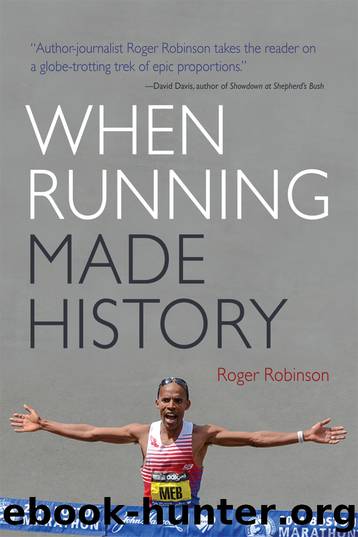When Running Made History by Roger Robinson

Author:Roger Robinson
Language: eng
Format: epub
ISBN: 9780815654438
Publisher: Syracuse University Press
Published: 2018-08-14T00:00:00+00:00
Heroes or villains? Nearly thirty years later, Johnson comes out as stubbornly naive rather than a calculating cheat. Lewis, clean under today’s rules though benefiting from some leniency at the time, remains in every way a man of elusive, physical perfection and a psychological enigma. I knew that Linford Christie had tested positive for the stimulant pseudo-ephedrine because of the laps I was running with Mike Turner, who told me with conviction how Christie’s positive test result was due to a ginseng medicine he had innocently taken for a cold. No doubt Mike’s advocacy as British team manager helped secure the narrow vote (11–10) that let Christie keep his bronze (eventually silver) medal. Mike was a very old friend. I kept my doubts to myself.
For me, there’s no question that, ultimately, the chief villain was Primo Nebiolo, the Mafia knockoff who ruled world track and field, sold the sport on world records, and concealed the drug-taking that policy demanded. When a proposal was put to the International Association of Athletics Federations (IAAF) by Great Britain and New Zealand to increase the penalty for doping from two years to four, Nebiolo and his medical chief Arne Ljungqvist blocked it. I told that story when reviewing Ljungqvist’s book, self-vauntingly titled Doping’s Nemesis (2011). A nemesis does not fight for lighter punishment. Nebiolo’s legacy was the critically diseased condition of world track and field in the years after his death.
This view owes something to my own observation of Nebiolo’s autocratic conduct, to private reports from members of the IAAF, and to the investigative books Lords of the Rings by Vyv Simson and Andrew Jennings (1992), and Jennings’s sequel, The New Lords of the Rings (1996). “The world’s sports leaders have misled us on dope testing,” they conclude (Simson and Jennings 1992, 185).
I include the Johnson–Lewis 100 m in a book mainly about much longer races not because I think doping in track and field has itself made history. In the big picture, it’s a minor symptom of a much greater malaise: society’s increasing dependency on drugs for all kinds of purpose, including performance enhancement in sports. Track and running were not conspicuous leaders in doping, even among sports. Bodybuilding, weight lifting, swimming, football, baseball, and, among endurance sports, cycling, were probably well ahead of running in dependency.
What that Seoul Olympic race did change historically was the world’s awareness. Instantly, the “Ben’s busted” sensation locked in place a profound global skepticism. Nothing would ever be sacred again. That loss of trust was what I already implied with my Chariots of Fire reference as they took their marks. No revelation or disqualification since has shocked us so sensationally. The disillusionment was deepened when the Canadian government appointed the Ontario Appeal Court Chief Justice Charles Dubin to conduct an inquiry into the Johnson case. His independent report (1990) exposed for the first time the extent of the problem and the complicity of the IAAF, International Olympic Committee (IOC), and their supposed medical commissions.
Since Ben was busted, there is a shadow in our minds over most world-class performances in every sport.
Download
This site does not store any files on its server. We only index and link to content provided by other sites. Please contact the content providers to delete copyright contents if any and email us, we'll remove relevant links or contents immediately.
| Cricket | Field Hockey |
| Lacrosse | Rugby |
| Track & Field | Volleyball |
Going Long by Editors of Runner's World(2328)
The Happy Runner by David Roche(2214)
Yoga For Dummies by Georg Feuerstein(1429)
Becoming Boston Strong by Amy Noelle Roe(1365)
Legacy by Kerr James(1278)
Winger by Smith Andrew(1243)
The Little Red Book of Running by Scott Douglas(1187)
Bowerman and the Men of Oregon by Kenny Moore(1103)
Wodehouse At the Wicket by P.G. Wodehouse(1102)
The Way of the Runner by Adharanand Finn(1087)
5050 by Dean Karnazes(1080)
Running Your First Marathon by Andrew Kastor(1059)
Swim, Bike, Run - Eat by Tom Holland(1031)
The Coming Storm by Nigel McCrery(999)
Blade Runner by Oscar Pistorius(998)
Spiked (Blocked Book 3) by Jennifer Lane(985)
The Grade Cricketer by Dave Edwards(961)
The Shared Origins of Football, Rugby, and Soccer by Christopher Rowley(961)
The Amazing Test Match Crime by Adrian Alington(951)
